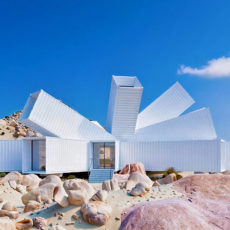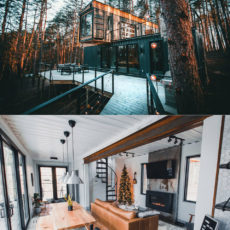
Photo credit: DLR/ESA
Why use a shipping container for a lunar project? FLEXHab (Future Lunar Exploration Habitat) is a genuine project, not a sci-fi fantasy, developed by SAGA Space Architects alongside the European Space Agency (ESA) and German Aerospace Center (DLR), based at the LUNA facility in Cologne, Germany’s European Astronaut Centre (EAC), to mimic life and work on the Moon.

Photo credit: DLR/ESA
FLEXHab is created from a modified 40-foot high-cube shipping container, turned into a small lunar habitat simulator. Its outside has a 3D-printed facade of glass fiber-reinforced polymer, shaped to look like a lunar habitat, with a weather-resistant coating to stay durable.
- Interactive model – Inspire kids to build a representation of the Earth, Sun and Moon in orbit with this LEGO Technic Planet Earth and Moon in Orbit...
- Educational space toy – Kids can turn the crank to see how the Earth and the Moon orbit around the Sun
- Includes months and moon phases – This solar system toy includes printed details, like the month and moon phases to help kids see how the Earth’s...

Photo credit: DLR/ESA
This structure was not built for actual Moon use but is a training and research tool to get astronauts ready for the tight, tough conditions of a real lunar base. It helps engineers test things like comfort, life support systems, as well as how humans get along in small spaces.

Photo credit: DLR/ESA
The habitat can house up to four astronauts, with four tiny, ventilated, soundproof capsule bedrooms (like Japanese capsule hotels), a kitchen area, a lab, a hygiene room that also works as an airlock, and a shared living space. Sony BRAVIA professional displays show lunar landscapes, acting like a “viewing dome” to make training feel real, and can also show emergencies like debris hits or pressure leaks for lifelike practice.

Photo credit: DLR/ESA
Color-changing circadian light panels help astronauts maintain healthy sleep patterns, easing the mental strain of tight spaces, while a computer system monitors temperature, air quality, and other conditions in real-time. Cork and natural materials in the decor make the space feel less sterile.
FLEXHab connects to the LUNA hall, a 700-square-meter test area filled with EAC-1 (a lunar dust simulant made from volcanic powder). This lets astronauts practice Moon surface tasks, like spacewalks, dust protection, and tool maintenance.
FLEXhab offers the space community tremendous opportunities. We can conduct studies on how a habitat should be optimally and functionally equipped and arranged. We can research which methods of rock analysis can be practically carried out on site in such a confined space in the future, and we can test various decontamination methods to find out how to minimise the amount of dust entering the living space,” said DLR.
[Source]










